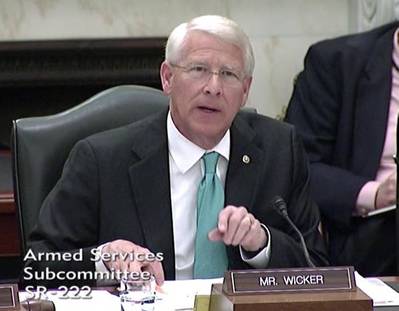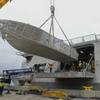U.S. Senator Roger Wicker, R-Miss., Chairman of the Senate Subcommittee on Seapower, delivered the following opening statement at today’s Subcommittee hearing to review Navy shipbuilding programs in the Defense Authorization Request for Fiscal Year 2017 and the Future Years Defense Program:
“The Senate Armed Services Subcommittee on Seapower convenes this afternoon to examine Navy shipbuilding programs. We welcome our three distinguished witnesses: The Honorable Sean J. Stackley, Assistant Secretary of the Navy for Research, Development, and Acquisition; Vice Admiral Joseph P. Mulloy, Deputy Chief of Naval Operations for Integration of Capabilities and Resources; and Lieutenant General Robert S. Walsh, Deputy Commandant for Combat Development and Integration, as well as Commanding General, Marine Corps Combat Development Command.
“Our Subcommittee is grateful for the decades of service to our nation from these three witnesses. We are grateful for the sacrifice also of our Sailors and Marines serving around the globe. With nearly 100 ships deployed on any given day, our Navy and Marine Corps continue to provide a critical front line of defense for our country.
“Now more than ever, a strong Navy and Marine Corps are central to our nation’s ability to deter adversaries, assure allies, and defend our national interests. Our Sailors and Marines are at the forefront of our rebalance to Asia, our ongoing operations against the Islamic State, our responses to a resurgent Russia, and efforts to deter rogue states such as Iran and North Korea.
“However, our current fleet of 272 ships is insufficient to address these critical security challenges. Even with recent shipbuilding increases, many of which were initiated in this Subcommittee, the Navy will not achieve its requirement of 308 ships until 2021. There is also no plan to meet the bipartisan National Defense Panel’s recommendation for a fleet of 323 to 346 ships.
“This afternoon, I would like to hear from our witnesses on what I consider five key issues that our Subcommittee will review this year:
“First, Vitality of the Industrial Base – The vitality of the 30-year shipbuilding plan is essential to the strength of our shipbuilding industrial base. The U.S. Navy’s dominant maritime position would not be possible without the unique skills, capabilities, and capacities inherent in new construction shipyards and weapon system developers. I would like our witnesses to describe how they carefully weighed the effects on the shipbuilding industrial base when they balanced resources and requirements in the shipbuilding plan.
“Second, Best Use of Taxpayer Resources – It is critical that this subcommittee conduct rigorous oversight of shipbuilding programs to ensure the Navy is making the best use of limited taxpayer dollars. Congress expects Navy shipbuilding programs to deliver promised capability on-time and on-budget. Schedule delays and unsatisfactory test results too often result in cost growth and strains on the legacy platforms these ships will replace.
“Specifically, I am interested in understanding why the delivery of the USS Gerald R. Ford (CVN 78), as well as its advanced arresting gear testing, have slid day-for-day since last September. Delivery is now slated for September instead of last month.
“I am also concerned by delays in Littoral Combat Ship mission package testing. Since 2009, the surface package has been delayed two years, the anti-submarine package for three years, and the mine countermeasures package for at least eight years.
“Additionally, after years of debating early retirement or inactivation of a number of Cruisers and Dock Landing Ships, last year Congress authorized and appropriated the Navy’s request to execute the so-called “2-4-6” plan. This means no more than 2 Cruisers may be inactivated per year, a Cruiser may not be inactivated for more than 4 years, and no more than 6 Cruisers may be in the program at any given time. However, in this year’s budget, the Navy has changed course and now wants to inactivate 7 Cruisers, instead of 2, and keep these 7 ships out of service for up to 10 years rather than 4 before re-activating and re-manning them. I hope the witnesses will explain the merits of this plan.
“Third, Building the Future Force – This Subcommittee also has a duty to shape the future of our Navy. Each of our classes of surface combatant ships – cruisers, destroyers, and littoral combat ships – will begin retiring within the next twenty years. Now is the time to determine the requirements for our future surface combatants, as well as the munitions they will carry.
“I am concerned that the extraordinary cost of the Ohio-class submarine Replacement Program will place tremendous stress on our already constrained shipbuilding budget, unless funding from outside this account continues to be provided. I am also interested in better understanding the Department’s decision to down-select to one variant of the Littoral Combat Ship frigate and the analysis that supports reducing procurement from 52 to 40 of these ships.
“Fourth, Amphibious Ships – The Navy and Marine Corps will serve as the linchpin of American force projection around the globe. I am interested in ways we can ensure the Navy shipbuilding plan addresses the demand from our combatant commanders for amphibious ships. This demand is greater than 50 amphibious ships on a day-to-day operational basis. The current inventory is just 30 amphibious ships. To this end, our Subcommittee would like to know to what extent the next amphibious assault ship, known as LXR, could be accelerated.
“Finally, Budget Constraints – Although the Bipartisan Budget Act has provided some measure of short-term relief, sequestration remains the law of the land regrettably and will return in fiscal year 2018 unless Congress acts. Even with these additional funds, the Department of the Navy continues to face significant budget challenges that force hard choices between readiness and modernization. The Department’s 2017 request is $8 billion, or 5 percent less than the 2017 value presented in last year’s budget.
“As a member of both the Armed Services Committee and the Budget Committee, I know that tough decisions must be made across the federal government. However, I would remind everyone that national defense is solely a federal responsibility. Defense spending is also known as a “twofer,” supporting both our national security and our high-tech manufacturing workforce.
“As such, I hope our witnesses today will elaborate on the hard choices in this budget and how a return to sequestration would impact the shipbuilding plan.”
(See a video of the hearing here: https://youtu.be/Ver0ZK5zXPU)











